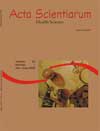<b>Enteroparasites in fecal and subungual matter from food handlers, Parana State, Brazil</b>- DOI: 10.4025/actascihealthsci.v31i2.4935
Keywords:
enteroparasites, fecal material, subungual material, food handlers, Southern Brazil
Abstract
This study shows the presence de enteroparasites in fecal and subungual material of 343 food handlers in the city of Cascavel, Paraná State, Brazil, from both genders and ages between 14 and 75 years. Fecal samples were analyzed using Lutz, modified Ritchie and Ziehl-Neelsen techniques, and subungual material was analyzed using the Ritchie method. Fecal samples were positive in 131 (38.2%) handlers. Species with highest prevalence were Endolimax nana (67.9%), Entamoeba coli (35.9%), Blastocystis sp. (28.2%), Entamoeba histolytica/dispar (10.1%) and Giardia duodenalis (8.4%), with E. nana being significantly different (p = 0.00) from the others. The infection by protozoa was greater than by helminths (p = 0.00). Association was observed between the positive results for some parasites and the male gender and professional category (p ≤ 0.05). The subungual material was positive in 17 individuals (5.0%), who had E. nana (2.9%), E. coli (1.2%), G. duodenalis (0.3%) and the association of E. nana and E. coli (0.6%), with no convergence observed between it and fecal material. The occurrence of enteroparasites in food handlers in Cascavel is high, indicating improper hygienic-sanitary conditions and the need for effective educational measures, to avoid the propagation of pathogenic organisms to food by manipulation.Downloads
Download data is not yet available.
Published
2009-09-17
How to Cite
Takizawa, M. das G. M. H., Falavigna, D. L. M., & Gomes, M. L. (2009). <b>Enteroparasites in fecal and subungual matter from food handlers, Parana State, Brazil</b>- DOI: 10.4025/actascihealthsci.v31i2.4935. Acta Scientiarum. Health Sciences, 31(2), 89-94. https://doi.org/10.4025/actascihealthsci.v31i2.4935
Issue
Section
Clinical Analysis
DECLARATION OF ORIGINALITY AND COPYRIGHTS
I Declare that current article is original and has not been submitted for publication, in part or in whole, to any other national or international journal.
The copyrights belong exclusively to the authors. Published content is licensed under Creative Commons Attribution 4.0 (CC BY 4.0) guidelines, which allows sharing (copy and distribution of the material in any medium or format) and adaptation (remix, transform, and build upon the material) for any purpose, even commercially, under the terms of attribution.
Read this link for further information on how to use CC BY 4.0 properly.























5.png)







